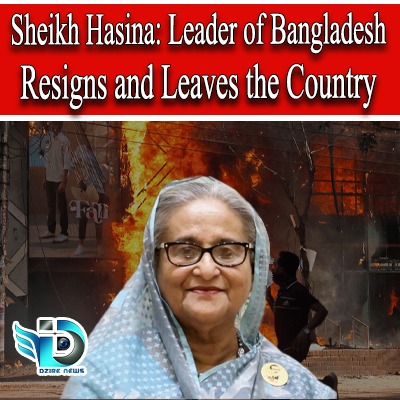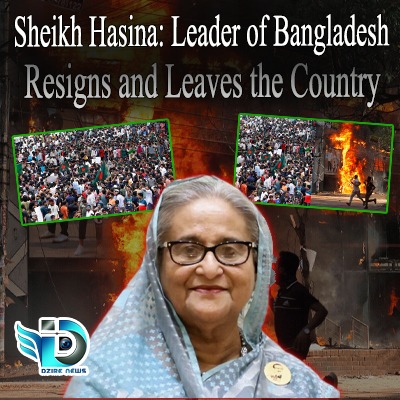Sheikh Hasina: Leader of Bangladesh Resigns and Leaves the Country -Dzire News
Sheikh Hasina: Leader of Bangladesh Resigns and Leaves the Country -Dzire News
Dzire News New Delhi– Sheikh Hasina resigned as Prime Minister of Bangladesh amongst widespread protests and rapidly rising violence across the unrest was fueled by public anger over a job quota system and a series of violent incidents during previous protests, which left at least 150 people dead and thousands injured. The situation was getting worse by allegations of extreme force used by the government against protesters. The ongoing validations, led primarily by student groups, demanded justice for those killed and criticized Hasina's handling of the situation, leading to her decision to step down.A personal aide told Al Jazeera that she fled in an army helicopter. Student protests in Bangladesh started because of deadly road accidents. People think Hasina hasn't done enough, responds weakly, and handles objections harshly, which angers students and many others. Sheikh Hasina, born on September 28, 1947, is a key figure in Bangladesh’s politics. As the daughter of the country’s founding father, Sheikh Mujibur Rahman, her life and career have been closely tied to the history of Bangladesh. She has served as Prime Minister several times,

achieving remarkable progress and facing many controversies. She was born in Tungipara, a village in the Gopalganj district of what was then British India. Her father, Sheikh Mujibur Rahman, later became Bangladesh’s first President and a leader in its
independence movement. Growing up in a politically active family deeply influenced her. Hasina studied at the University of Dhaka, earning her bachelor's degree. In 1975, her father and most of her family were eliminated, forcing Hasina and her sister into transport in India.
Hasina returned to Bangladesh in 1981 and became the leader of the Awami League, her father’s party. She worked hard to rebuild the party’s strength. In 1996, Hasina became Prime Minister for the first time. She focused on economic reforms,
women’s rights, and improving relations with India. She signed the Ganges Water Treaty with India to resolve water-sharing arguments. However, her term was marked by political instability and corruption allegations. Despite this, she made remarkable progress in infrastructure and social policies. After a period out of power, Hasina returned as Prime Minister in 2009. Her second term saw strong economic growth, infrastructure development, and improvements in the energy sector. She launched initiatives like Digital Bangladesh Vision 2021 to transform the country into a knowledge-based economy. Her administration faced criticism for its handling of political opposition and human rights issues. The 2014 elections, boycotted by the main opposition party, led to further political unrest.
Hasina’s upcoming terms continued to focus on economic development, with notable growth rates and improvements in social indicators. Projects like the Padma Bridge aimed to better connectivity and boost the economy. Despite these achievements, her leadership has been controversial. Critics charge her of dictatorship, repressing free speech, and manipulating the judiciary. The Rohingya refugee crisis, with over a million refugees from Myanmar, posed a major challenge. In recent years, Hasina’s government has faced both praise and criticism. Her policies have driven economic growth and development, but concerns about democratic backsliding and human rights violations have grown. One major controversy is her handling of the opposition. Opposition leaders and members have faced arrests, and there are allegations of electoral fraud. International observers have raised concerns about democracy in Bangladesh under Hasina's rule. In the past few weeks, Hasina made headlines by pushing several significant policies. Her government approved a major deal with China to upgrade the country’s infrastructure, including ports and railways. She also announced a new initiative to provide financial support to small businesses affected by the global economic downturn. However, these actions have been overshadowed by rising political tensions and public protests against her administration’s handling of recent elections. Sheikh Hasina s resignation might harm India-Bangladesh relations, impacting trade, border security, regional projects, and regional politics. Sheikh Hasina’s legacy is complex. She has driven Bangladesh’s economic transformation, lifting millions out of poverty and positioning the country as a key player in South Asia. Her focus on infrastructure, healthcare, and education has made a everlasting impact. However, her shift has been damaged by allegations of dictatorship, human rights abuses, and political repression. Her leadership style has divided opinion, with supporters praising her as a visionary leader and critics attack her governance.

Sheikh Hasina story is one of strength, ambition, and controversy. From her early life as the daughter of Bangladesh’s founding father to her multiple terms as Prime Minister, she has shaped the country’s modern history. As news of her resignation and departure unfolds, the world watches to see what the future holds for her and Bangladesh. How history will remember
her will depend on future events and the judgment of generations to come.
Sanjeev sharma
Editor in Chief
Ms Alisha Shahid
Asstt.Sub Editor

